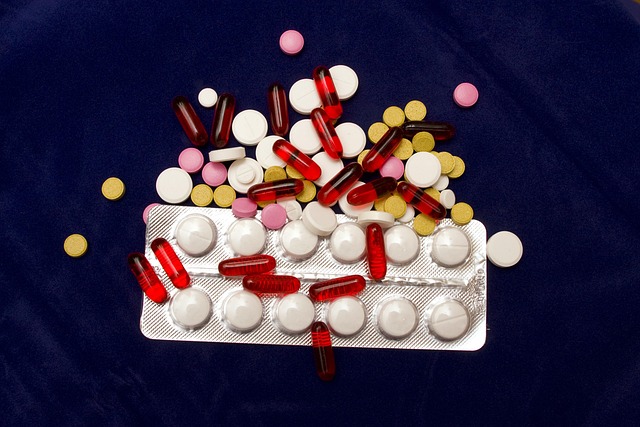Semaglutide, a GLP-1 receptor agonist, is a once-weekly injection for managing type 2 diabetes and obesity. Starting at 0.25 mg weekly, doses are strategically increased by 0.25 mg increments every four weeks until the effective dose of 1 mg or 2 mg is reached. Key factors influencing dosing include age, weight, kidney function, and medical conditions. Regular monitoring (every 2-4 weeks) tracks vital signs, weight, and blood test results to manage side effects like nausea, vomiting, pancreatitis, and kidney problems. User-friendly devices enhance patient convenience and adherence to the once-weekly injection schedule. Special populations may require tailored dosing adjustments based on health status. Future research aims to personalize semaglutide dosing strategies based on diverse patient characteristics and long-term safety/efficacy assessments.
“Discover the intricacies of semaglutide dosing, a groundbreaking medication designed for type 2 diabetes management. This comprehensive guide explores the standard dosing regimen, from understanding its mechanism and purpose to navigating initial doses, titration processes, and influencing factors. Learn about various dosage forms, monitoring practices, adverse effects, patient compliance considerations, and special population adaptations. Uncover future research insights shaping semaglutide dosing, making it a game-changer in diabetes treatment.”
Understanding Semaglutide and Its Purpose

Semaglutide is a medication designed to mimic a natural hormone that helps regulate blood sugar levels in the body. It belongs to a class of drugs known as glucagon-like peptide-1 (GLP-1) receptor agonists, which have gained significant attention for their role in managing type 2 diabetes. By mimicking GLP-1, semaglutide enhances insulin secretion when blood sugar is high and suppresses glucagon release, leading to a decrease in blood glucose levels.
The purpose of semaglutide lies in its ability to provide a more stable blood sugar control compared to traditional insulin therapies. Its unique dosing regimen, which involves once-weekly injections, offers convenience and flexibility for patients. Understanding the optimal semaglutide dosing is crucial as it can significantly impact glycemic control, weight management, and overall patient adherence to the treatment plan.
Standard Dosing Schedule: An Overview

The standard dosing regimen for semaglutide, an innovative glucagon-like peptide-1 (GLP-1) receptor agonist, involves a careful balance to achieve optimal therapeutic effects while minimising adverse reactions. Typically, the initial dose is low, starting at 0.25 mg once weekly, allowing the body to tolerate the medication. After a few weeks of adjustment, the dosage can be increased to 0.5 mg or 1 mg, depending on individual patient responses and their specific treatment goals, such as weight loss or blood glucose control.
This dosing schedule is designed to mimic the natural release of GLP-1 in the body, providing sustained benefits over time. Consistency is key; patients should adhere strictly to the prescribed schedule for maximum effectiveness. Regular monitoring by healthcare professionals is essential during this process, enabling them to make informed adjustments and ensure the best possible outcome for each patient’s unique semaglutide journey.
Initial Dose and Titration Process

The initial dose of semaglutide is typically started at 0.25 mg, administered subcutaneously once weekly. This low starting dose allows for gradual adaptation to the medication and minimises potential adverse effects. Over a period of 4 weeks, the dose is titrated up in steps of 0.25 mg until the optimal dose of 1 mg per week is reached. The titration process considers individual patient responses, with adjustments based on clinical efficacy and tolerability.
A slow increase in dosage enables the body to acclimate to semaglutide’s effects, particularly regarding its role in glucose control and weight management. This strategic approach ensures that patients experience benefits while minimising side effects commonly associated with semaglutide therapy, such as nausea or gastrointestinal distress.
Factors Influencing Dosage Adjustment

Several factors can influence the optimal dosage adjustment for semaglutide. Patients’ individual characteristics, such as age, weight, kidney function, and other medical conditions, play a crucial role in determining the most effective and safe dose. For instance, patients with impaired kidney function may require lower starting doses or more frequent monitoring to prevent adverse effects. Similarly, individuals with certain metabolic disorders or those taking other medications that interact with semaglutide might necessitate dosage modifications. Additionally, response to treatment is a key consideration. Blood sugar levels, weight changes, and the patient’s overall glycemic control should be carefully monitored to determine if a higher or lower dose of semaglutide is needed.
Common Dosage Forms of Semaglutide

Semaglutide, a glucagon-like peptide-1 (GLP-1) receptor agonist, is typically administered via subcutaneous injection. The most common dosage forms include vials and prefilled syringes, both of which allow for precise dosing and easy administration at home. Patients are usually initiated on a low dose, such as 0.25 mg or 0.5 mg once weekly, and then gradually increased to the maintenance dose of 1 mg or 2 mg depending on individual response and tolerability.
These dosage forms offer flexibility in terms of dosing frequency, with options ranging from daily injections to every other day injections, catering to diverse patient needs and preferences. Additionally, prefilled syringes have been designed to simplify the injection process, making it more user-friendly for patients who may be less familiar with administering injections. This accessibility is crucial in ensuring adherence to the semaglutide dosing regimen, which can lead to significant improvements in glycemic control for individuals with type 2 diabetes.
Monitoring and Adverse Effects: What to Expect

When on a semaglutide dosing regimen, regular monitoring is crucial to assess its effectiveness and manage potential adverse effects. Patients should schedule frequent check-ins with their healthcare providers, typically every 2-4 weeks, depending on the prescribed dosage and individual response. During these visits, vital signs, weight, and blood tests will be monitored to track changes in blood sugar levels, kidney function, and lipid profiles. These checks are essential as semaglutide can cause various side effects, common ones including nausea, vomiting, diarrhea, constipation, and stomach pain. More severe but less frequent reactions may involve pancreatitis, gallstones, or kidney problems.
Healthcare professionals will guide patients on recognizing these symptoms and provide support to manage any adverse effects. It’s important to report any unexpected or concerning changes promptly, as they can indicate a need for dose adjustments or alternative treatments. Effective communication between patient and provider ensures optimal management of semaglutide therapy, maximizing its benefits while minimizing potential risks associated with standard dosing regimens.
Patient Compliance and Convenience Considerations

Patient compliance and convenience are essential aspects to consider when discussing the standard dosing regimen for semaglutide. Effective adherence to treatment is influenced by various factors, including the administration method, dosage frequency, and patient-specific preferences. The once-weekly injection schedule of semaglutide offers a convenient alternative to more frequent administrations, potentially improving patient compliance. This simplicity can lead to better medication retention and overall therapy adherence, especially when compared to medications requiring daily injections or complex delivery systems.
Additionally, the development of user-friendly devices and packaging can enhance patient convenience. Modern autoinjectors designed for semaglutide administration are engineered to be easy to use, reducing the learning curve associated with self-injection. Simplifying the dosing process not only improves patient satisfaction but also encourages consistent medication use, which is crucial for achieving optimal therapeutic outcomes in managing conditions such as type 2 diabetes or obesity.
Special Populations and Dosage Modifications

When considering semaglutide dosing, special populations such as elderly patients, individuals with kidney or liver disease, and those with a history of diabetes complications may require dosage adjustments. In these cases, healthcare providers should carefully monitor the patient’s response to therapy. Elderly patients might start on a lower dose, while those with reduced kidney or liver function may need a reduced dose frequency or even dose reduction. It’s crucial to tailor semaglutide dosing based on individual health status and clinical judgment.
Additionally, patients with a history of gastrointestinal issues or those undergoing certain medical procedures may also necessitate modifications in their semaglutide dosing regimen. Regular communication between the patient and healthcare provider is essential to ensure optimal dosing and safety during treatment with semaglutide.
Future Insights and Research on Semaglutide Dosing

Future research and clinical trials will play a pivotal role in unraveling the optimal semaglutide dosing strategies, especially for diverse patient populations. As our understanding of this drug’s pharmacokinetics and individual responses deepens, personalized dosing approaches could become the norm. These studies may explore the impact of factors like age, body composition, comorbidities, and metabolic profiles on semaglutide absorption, distribution, and elimination, enabling tailored prescriptions.
Additionally, investigating long-term safety and efficacy will be essential, particularly in identifying potential late-onset side effects related to prolonged exposure. Optimizing semaglutide dosing protocols could further enhance patient adherence and outcomes, making this medication a more accessible and effective tool in the management of type 2 diabetes and weight management.
